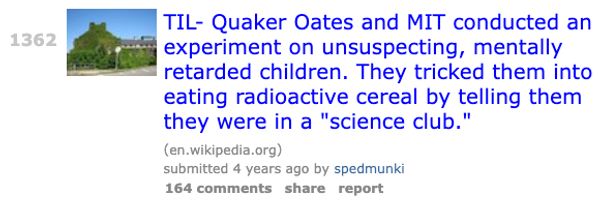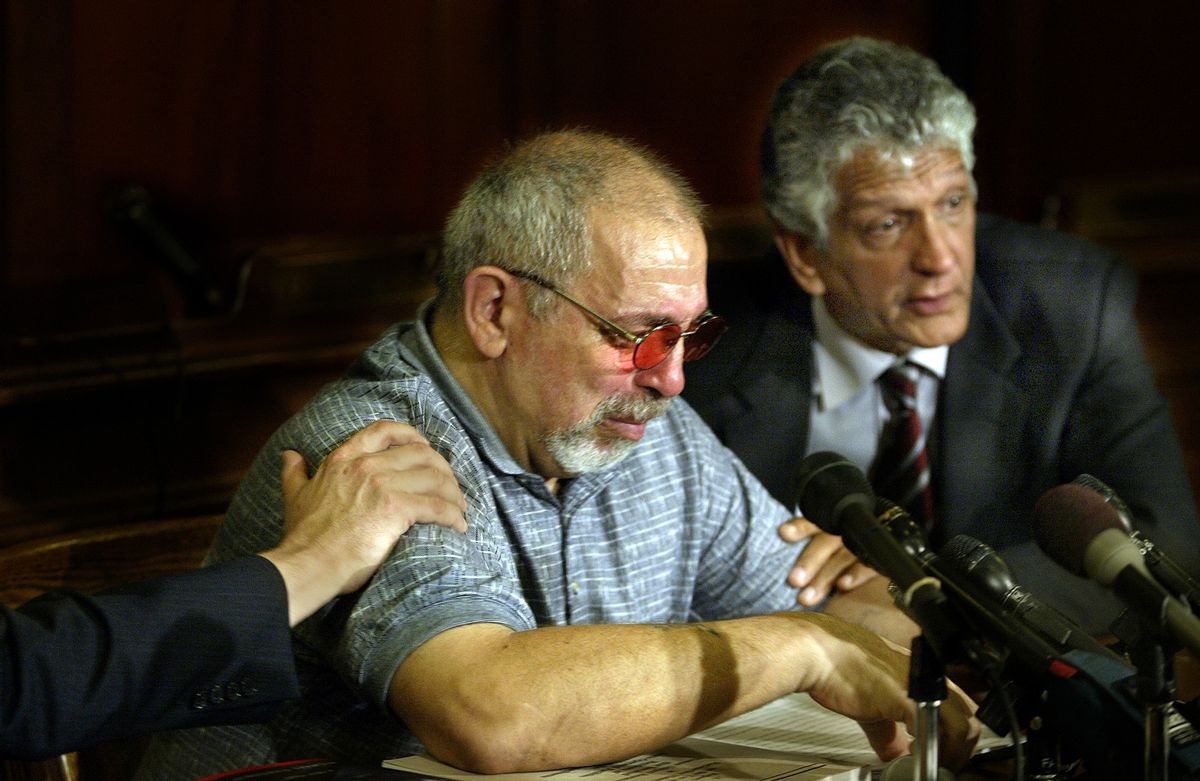A topic that often emerges as something that sounds too bad to be true involves claims related to Quaker Oats' funding research that fed radioactive oatmeal to unsuspecting children housed at a state institution. These unwitting subjects, the story goes, were given gifts and trips to baseball games in return for their uninformed consent. They were told they were part of a "science club."

These details are true. Though the research, conducted in the 1950s, was never secret or hidden, it came to wide public attention in the early 1990s. In late 1993, U.S. Department of Energy (DOE) Secretary Hazel O'Leary launched an initiative to highlight past research supported by the DOE involving human subjects and radiation now considered to be highly unethical.
On Dec. 26, 1993, the Boston Globe released a front page investigation into a set of experiments mentioned in that DOE review that had been conducted on subjects from the Walter E. Fernald State School in Massachusetts:
Records at the Fernald State School list them as "morons," but the researchers from MIT and Harvard University called the retarded teenage boys who took part in their radiation experiments "the Fernald Science Club."
In the name of science, members of the club would eat cereal mixed with radioactive milk for breakfast or digest a series of iron supplements that gave them the radiation-equivalent of at least 50 chest X-rays.
From 1946 to 1956, scores of retarded teenagers consumed radioactive food to help the researchers better understand the human digestive process.
These experiments sought to see what effect cereal and other breakfast foods had on the absorption of elements like iron and calcium. To achieve the information needed, the nutrients at issue needed to be traced. Radioactive isotopes of iron and calcium, which would be absorbed by the body the same as the non-radioactive kind, could be traced with Geiger counters.
These experiments were run, primarily, by a then-PhD student at MIT named Felix Bronner. He was, during the time some of these experiments were conducted, funded as a "Quaker Oaks Fellow."
Harvard and MIT have each acknowledged their role in these experiments. In 1994, following the completion of a task force's report on the research, MIT's Dean of Research issued this statement decrying the lack of informed consent but concluding that "no harm was done":
J. David Litster, MIT vice president, dean for research and professor of physics, said in a statement:
"Chairman Fred Misilo, the Rev. Doe West and the entire Task Force on Human Subject Research are to be congratulated for the hard work and thought they have put into completing a difficult mission over the past four months.
"As MIT President Charles M. Vest said in January, MIT has expressed its sorrow that the young people who participated decades ago in the nutritional tracer studies-and their parents-apparently were not informed that the study involved radioactive tracers in very small amounts.
"I am pleased that the Task Force has confirmed MIT's initial impression that no harm was done to the participants in the cereal nutrition studies that were the initial focus of publicity," Professor Litster said.
Quaker Oats, along with MIT, settled a class action lawsuit brought by former students involved in the experiments regarding the radiation tests in 1998, but the company has denied it played a large role in the research, as reported by The New York Times in 1998:
Quaker Oats continues to deny that it played a large role in the experiments. The company donated the cereal and gave a ''small research grant'' to the university, said a Quaker spokesman, Mark Dollins.
Below, Snopes provides the historical context behind many assertions made about these experiments.
Were the Subjects or Their Parents Not Told About the Radiation?
The Federal Task force looking into the informed consent of these experiments was able to locate copies of some "permission" letters sent to parents about their child's potential participation in these experiments:
May 1953
Dear Parent:
In previous years we have done some examinations in connection with the nutritional department of the Massachusetts Institute of Technology, with the purposes of helping to improve the nutrition of our children and to help them in general more efficiently than before.
For the checking up of the children, we occasionally need to take some blood samples, which are then analyzed. The blood samples are taken after one test meal which consists of a special breakfast meal containing a certain amount of calcium. We have asked for volunteers to give a sample of blood once a month for three months, and your son has agreed to volunteer because the boys who belong to the Science Club have many additional privileges. They get a quart of milk daily during that time, and are taken to a baseball game, to the beach and to some outside dinners and they enjoy it greatly.
I hope that you have no objection that your son is voluntarily participating in this study. The first study will start on Monday, June 8th, and if you have not expressed any objections we will assume that your son may participate.
Sincerely yours,
Clemens E. Benda, M.D.
[Fernald] Clinical Director
Approved:_____________________
Malcom J. Farrell, M.D.
[Fernald] Superintendent
Clemens Benda was a professor at Harvard Medical School in addition to working at the Fernald School. Notably, these letters show that the parents were presented with an "opt-out" choice, meaning that, in lieu of their explicit disapproval, the school would use their children as they saw fit.
Even more notably, the letter does not mention radiation.
The acknowledgement section of several papers produced from this research misleadingly states that the students were willing participants in the experiments:

Were the Students Given Enticements and Told They Were in a 'Science Club'?
The above permission letter makes clear that the school and researchers described the students involved as part of a science club. Constantine J. Maletskos, one of the researchers on the experiments from MIT, testified that the "Science Club" aspect of the experiments had been misinterpreted by the press cynically:
It was an afterthought, as I gather—that somebody was talking about: "It would be nice [to do something for them because] these kids have been involved, we've had to jab them [with needles], and they had to eat a meal—every little drop of it, because you wanted to be sure they got 100 percent of the radioactivity— wouldn't it be nice to do something for them?"
So to make them feel like they were special, they called it the Science Group, and the only thing they got was one meal, maybe twice in their whole career, outside of the institution at the MIT Faculty Club and as I remember, and they got a [small] present.
Fred Boyce, a former student at Fernald who was a participant in the radiation experiments, told People Magazine in 1998 that life at the school, run at the time by outspoken eugenicist, was so brutal that a student would volunteer to do anything, including eat arsenic, to get away:
Daily life was a numbing mix of boredom and brutality. Boyce recalls how an attendant watching over a ward of 36 children would force them to sit on wooden benches for hours with arms folded. "If you unfolded your arms," he says, "you were whacked." Any opportunity to escape Fernald was so irresistible, Boyce says, that had the scientists offered an outing in exchange for taking arsenic, he would have agreed: "My hand is up! I want it! We're going to a ball game!"
Boyce described being "lured into the experiments five decades ago with gifts of Hopalong Cassidy mugs, boat rides and outings to Boston Braves baseball games." Boyce was instrumental in securing a victory in a class action lawsuit against MIT and Quaker Mills.
What Role Did the Federal Government Have?
The Federal Government played a role in this research as well. The radioactive isotopes used in these experiments, according to the papers published from their work, were provided by the United States Atomic Energy Commission (AEC). As acknowledged in one calcium paper:
Authorization for the use of restricted quantities of Ca [isotopes] in patients institutionalized for mental inadequacy was granted through the Subcommittee on Human Applications by the Isotope Division of the Atomic Energy Commission. The Ca [isotope] was obtained on allocation from the Oak Ridge National Laboratory.
The government's support of these and other projects led, in part, to the creation of a Department of Energy Task Force, as described in a report that group published a year later:
At a December 1993 press conference, Secretary of Energy Hazel R. O'Leary released documents describing previously secret U.S. nuclear tests, facts about bomb-grade plutonium, and information about fusion energy. The Secretary also made available some documents related to human radiation experiments, particularly the 1945-1947 injections of 18 human subjects with plutonium. She committed DOE to the collection and review of historical data about the experiments and undertook to release as much information as legally possible.
Why Did They Choose These Subjects in the First Place?
Maletskos, the MIT professor, explained in a 1993 oral history that using institutionalized students for subjects was beneficial since they were broadly exposed to the same conditions day after day, limiting the number of confounding variables:
There are different ways to look at it. People can look at it [(the use of these subjects)], read it in a bad way. Let me put it in context. Once you find the source [of people to participate in an experiment], then you tend to go back to the source because you've already done all the [lengthy administrative] machinery leading up to getting the permission to use people who are involved in that organization.
So, I'm sure that sort of thing was playing in[to the decision to] go back to the Fernald School to get other subjects. Because in all of these experiments, you have to have control of the subjects. You just can't let them walk around; you have to collect 100 percent of the excretions, you have to see that they're eating properly, and all this kind of thing[, including the maintenance of a stable metabolism]. Unless you do it that way, you're not going to have a good experiment.
The lack of informed consent as well as physical benefit to the students makes these studies widely unethical by today's standards, even if the radiation — as several task forces concluded — was not high enough to cause harm.
For one, the experiment did not fully inform either the children or their parents of the methods used in the experiment. On top of that, the parents were falsely told that the experiments would "improve the nutrition of our children and to help them in general more efficiently than before."
As described in a DOE Task Force report, "there was no basis, however, for the implication in both [permission] letters that the project was intended for the children's benefit or improvement. This was simply not true."
The Bottom Line
These experiments were never "secret," unlike other things disclosed in the DOE review. The papers were publicly discussed and published and the methods described (after the fact) openly. They were, however, secret enough that many of the actual participants had no idea the cereal they had eaten as part of their science club contained radioactive isotopes until the DOE began highlighting this work.
While the experiments do not appear to have caused harm to the participants, they are considered wildly unethical by today's standards.

